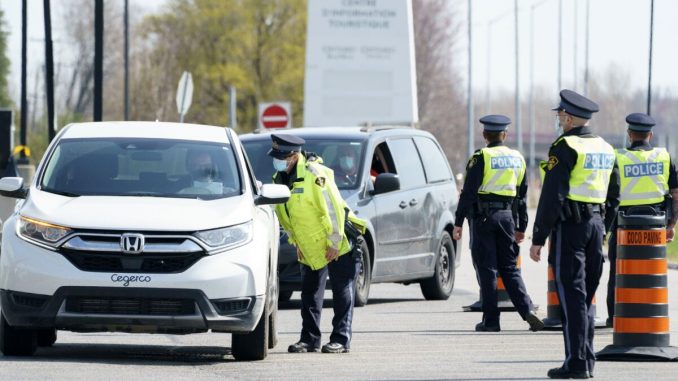

Commentary
After a year of draconian measures meant to “flatten the curve” on the COVID-19 pandemic, last week Ontario Premier Doug Ford revealed that his province is worse off than ever before, with record numbers now in hospital with COVID-19.
Did Ford respond by stepping back to rethink the strategy that levelled Ontario’s economy without improving the state of its health? Did he fire the incompetent public-health bureaucrats that only made things worse? Did he learn from the many jurisdictions around the world that are succeeding in managing the pandemic?
No, Ford instead doubled down on his failed policies by locking down the province for another four weeks and, for good measure, by calling out the cops to intimidate anyone who might defy his stay-at-home orders.
But the abject failure can’t all be chalked up to Ford. He inherited one of the industrialized world’s least capable health-care systems. According to a Financial Accountability of Ontario (FAO) report last year that compared the province’s health-care system to those in the 42 OECD countries, Ontario ranked among the worst in terms of hospital beds per capita, and was the very worst in providing the spare capacity that hospitals need routinely, let alone during a pandemic. As one example of the complacency of public health in Ontario, in January it opened its first newly built hospital in 30 years, a project almost two decades in the making.
But if Ford was dealt a bad hand, he couldn’t have played it any worse.
When it became apparent that Ontario would require a great deal of additional hospital capacity to cope with the pandemic, Ford didn’t expedite a concerted plan to rapidly upgrade the sad state of the province’s hospitals. Rather, he skimpily increased the number of new acute-care beds by less than 7 percent. To free up beds for the expected high-profile pandemic patients, Ford mostly chose to deny service to tens of thousands of Ontarians whose cardiac procedures, cancer screenings, hip replacements, prostate operations, cataract surgeries, and other needs could be classified as “elective”—even though, according to the FAO: “Since most of the delayed procedures are medically required, the longer procedures are postponed, the worse outcomes Ontarians could have and the harder it will be for hospitals to eventually clear the backlog of delayed procedures.”
Where Ford had the most authority and ability to act, and where the need to act forcefully was most critical—the long-term care homes that were all either government-run or government-regulated—he imposed lax, toothless lockdowns that management and staff repeatedly ignored. In one such home in Scarborough, cited 13 times by provincial inspectors, staff failed to use protective gear, went from room to room without changing gowns, and otherwise ignored required infection-prevention measures. In good part due to Ford’s failure to focus on real and not imagined problems, the majority of Ontario’s fatal COVID-19 cases stem from outbreaks in long-term care homes.
In contrast to lax lockdowns where their need was real, Ford imposed severe lockdowns on imaginary problems that proved perverse. The extent of the perversity can be seen in a CDC study of nearly 150,000 adults that found almost 80 percent of those who required COVID-related hospital care were either overweight (28.3 percent) or obese (50.8 percent), and in a Kaiser Permanente study of nearly 50,000 adults that showed inactivity to be strongly associated with a risk of hospitalization, ICU admission, and death.
Although the best way to flatten the curve is to flatten the stomach, Ford’s latest stay-at-home order placed restrictions on golf, tennis, soccer, camping and other outdoor activities that promote fitness, along with restrictions on gyms. Consistent with what might be expected from lockdowns, a February 2021 Harris poll shows that, since the pandemic started, 42 percent of American adults reported undesired weight gain averaging a curve-bulging 29 pounds.
Other Ford perversities included shutting down schools, where the healthy young face almost no risk to their health, and generally preventing the herd immunity that’s ultimately the best guarantor of a healthy populace.
It isn’t as if Ford didn’t have examples of what works. While Ontario’s hospitals are bracing for inundation and its daily deaths are expected to soar to triple digits, Sweden’s hospitals have coped relatively well throughout the pandemic, and daily deaths have fallen to single digits. No-lockdown Sweden has fewer deaths per capita than lockdown European countries such as the U.K., France, Italy, and Spain. Florida, too, which early on abandoned a lockdown policy, has performed better than lockdown states, despite its large elderly population.
Lockdowns were “a huge mistake,” Florida Governor Ron DeSantis said on April 16. “We shouldn’t have gone down that road.” His regret over mindlessly following the lockdown fashion is echoed in a Wall Street Journal op-ed titled “The Lockdowns Weren’t Worth It,” which notes that “not a single government has published a cost-benefit analysis to justify lockdown policies—something policy makers are often required to do while making far less consequential decisions.”
Ford, like other me-too leaders, has required no cost-benefit analysis before taking his province off a cliff. He is captive to the vagaries of a handful of public-health bureaucrats who are incapable of bucking an orthodoxy that generates failure upon failure. And until that changes, Ontarians will be captive as well.
Lawrence Solomon is an author and columnist with The Epoch Times. LawrenceSolomon@nextcity.com @LSolomonTweets
Views expressed in this article are the opinions of the author and do not necessarily reflect the views of The Epoch Times.





Be the first to comment